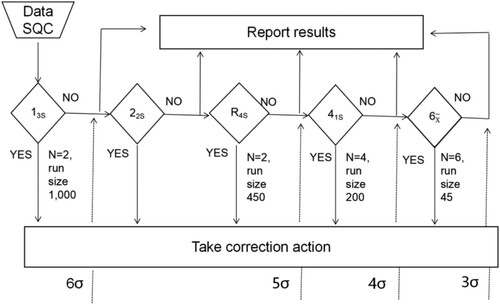Figures & data
Table 1. Sigma metric for the different instruments in this study at two levels of quality control.
Figure 1. Westgard sigma rules with recommended batch sizes and levels of QC (cited from website http://www.clinet.com.cn/sigmapv/#sgm4). Sigma metric = (TEa − |bias|)/CV. The sigma scale is located at the bottom of the diagram. Initially, the sigma metric is defined, and the corresponding sigma scale value is used to identify the control rules, total number of quality control materials (N) and frequency of statistical quality control events (run size). For example, the analytical performance of an analyte of more than 6 sigma corresponds to the single rule of 13s (N = 2, R = 1), with two different quality control materials with a batch size of 1000 patient samples, which is recommended as the IQC program. However, if the analytical performance of An analyte is between 3 and 4 sigma, multiple rules of 13s/22s/R4s/41s (N = 6, R = 1) with six different quality control materials with a batch size of 45 patient samples are recommended as the IQC program. ‘Yes’ means that the rule is violated, necessitating rejection of the results and corrective action; ‘No’ means that the rule is not violated, so accept and report the results.

Table 2. QC procedures selected for 5 analytes in different instruments
Table 3. The QGI and quality improvement measures for 5 analytes with sigma <4.
